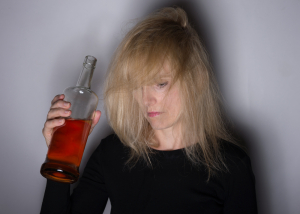Like with general medical illness a psychotic disorder due to a substance can be caused by alcohol, illicit drugs, but also from side effects of medications. Moreover, on withdrawal of some substances psychosis can also occur.
For instance, when a patient is an alcoholic and is used to regular intake of a high percentage alcoholic beverage such as whiskey and this patient suddenly stops drinking, withdrawal will occur; there often will be a full-blown withdrawal psychosis (delirium tremens) within 48 hours. Typically the auditory hallucinations consist of voices, but there often are also visual hallucinations and tactile hallucinations such as bugs crawling over the bed sheet and on the skin.
In intoxication psychosis such as with amphetamine or cocaine intoxication similar hallucinations and delusions occur. In this setting persecutory delusions may develop shortly after using amphetamines or cocaine (see Ref.2).
There may be a distortion of the body image when looking in a mirror, or peoples faces are being misinterpreted as the brain makes connections where there aren’t any. The patient also may have tactile hallucinations “feeling” imaginary bugs underneath the skin and scratching the skin to the point of injury. With cannabis psychosis does not develop that frequently, but when it does, it does so early on with the development of marked anxiety, frequent mood changes and persecutory delusions. After the episode there often is no memory of it(amnesia). The higher he blood levels of cannabis are the more likely hallucinations occur.
When amphetamine or cocaine use has been stopped after the occurrence of a psychosis, the psychosis may not stop the way the patient and he physician had hoped for. Sometimes these psychotic states can last weeks or even months past the point where drug use was stopped, even when the patients are treated with antipsychotic medication. The reason may be that there can be toxic changes of the brain receptors and changes in the brain metabolism that take time to repair(see Ref. 4).
Some regular medications such as anesthetics used for surgeries, anti seizure medications, antihypertensives, antihistamines, antibiotics, corticosteroids, non steroidal anti-inflammatory medications, muscle relaxants and even over-the-counter cold remedies like phenylephrine or pseudoephedrine can all lead to psychotic symptoms.
It is not known what makes some patients more susceptible than others, but factors that have been identified are differences in enzymatic elimination rates in liver and kidneys leading to fluctuating blood levels. In some patients very high levels lead to psychosis. Other patients at risk are older patients, particularly above 75 years of age, where the elimination of medications is hampered due to a much reduced kidney function as well as a slower metabolism. Often medications have to be reduced and drug companies often offer medication with reduced dosages for older patients. Drug interactions are another factor, if the patient is taking several medications for different organ systems.
For many medications or toxic substances the same set of detoxifying enzymes are needed in the liver to eliminate them from the blood stream. This creates an overload situation and toxic blood levels causing psychosis can result. You may have read warnings about using the over-the-counter antihistamine Seldane (removed from the market in 1998) when the patient was also on erythromycin for an infection. Each of these used separately alone are harmless, but when taken together they can cause serious harm. Some of the medications such as anti-epileptic drugs or theophylline levels for asthmatics, which also have this interaction in the liver, can be monitored through serial blood level determinations. This avoids toxic levels in cases where both these medications have to be taken together.
References:
1. Dr. David Burns: “Feeling good –The new mood therapy”, Avon Books, New York,1992.
2. Diagnostic and Statistical Manual of Mental Disorders, Fourth Edition, (DSM-IV),American Psychiatric Association, Washington,DC,1994.
3. Dr. Shaila Misri at the 46th St. Paul’s Hosp. Cont. Educ. Conference, November 2000, Vancouver/B.C./ Canada.
4. JM Loftis et al. J Neurochem 2000 Nov 75(5): 2040-2050.
5. B. Zilbergeld et al. “Hypnosis – Questions& Answers”, W.W. Norton & Co, New York,1986: 307-312.
6. MH Erickson & EL Rossi:”Hypnotherapy, an exploratory casebook”, Irvington Publishers Inc., New York, 1979: chapter 8, 314-363.
7. G Steketee et al. Compr Psychiatry 2001 Jan 42(1): 76-86.
8. DS Mennin et al. J Anxiety Disord 2000 July-Aug 14(4): 325- 343.
9. J Hartland: “Medical &Dental Hypnosis and its Clinical Applications”, 2nd edition, Bailliere Tindall,London,1982, page: 326-336.







